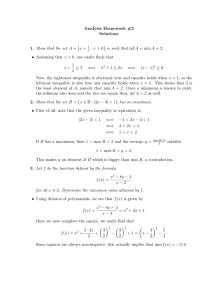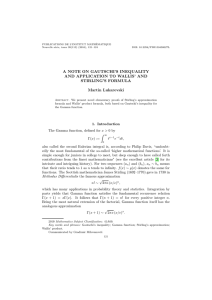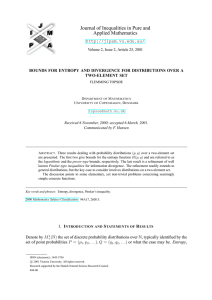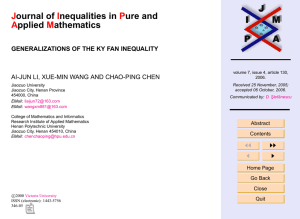Proof of the best bounds in Wallis’ inequality Chao-Ping Chen
advertisement
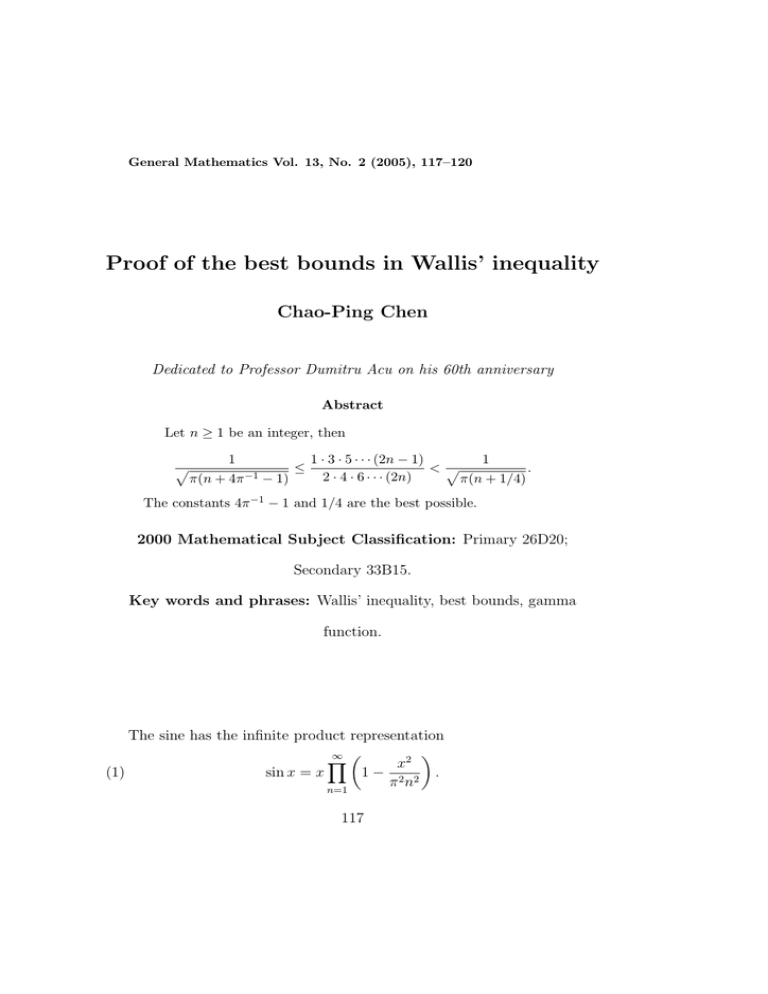
General Mathematics Vol. 13, No. 2 (2005), 117–120
Proof of the best bounds in Wallis’ inequality
Chao-Ping Chen
Dedicated to Professor Dumitru Acu on his 60th anniversary
Abstract
Let n ≥ 1 be an integer, then
p
1
π(n +
4π −1
− 1)
≤
1
1 · 3 · 5 · · · (2n − 1)
<p
.
2 · 4 · 6 · · · (2n)
π(n + 1/4)
The constants 4π −1 − 1 and 1/4 are the best possible.
2000 Mathematical Subject Classification: Primary 26D20;
Secondary 33B15.
Key words and phrases: Wallis’ inequality, best bounds, gamma
function.
The sine has the infinite product representation
∞ Y
x2
(1)
sin x = x
1− 2 2 .
π n
n=1
117
118
Chao-Ping Chen
Taking in (1) x = π/2 gives well known the Wallis formula
∞ π Y
(2n)2
=
.
2 n=1 (2n − 1)(2n + 1)
(2)
Motivated by (2), Kazarinoff [2] proved that
(3)
q
1
π n+
<
1
2
1 · 3 · 5 · · · (2n − 1)
1
<q
2 · 4 · 6 · · · (2n)
π n + 14
for n ∈ N, the set of positive integers. We here show that, for n ∈ N,
(4)
1 · 3 · 5 · · · (2n − 1)
1
1
p
≤
,
<p
2 · 4 · 6 · · · (2n)
π(n + 4π −1 − 1)
π(n + 1/4)
improving the lower bound and confirming the upper in (3), by a very simple
argument. We also prove that the bounds in (4) are the best possible.
Proof. It is clear that
Γ(n + 1) = n!,
1 (2n − 1)!! √
π,
Γ n+
=
2
2n
2n n! = (2n)!!.
To prove the right hand inequality of (4), it suffices to show that
q
1
Γ n+ 2
n + 14
(5)
Rn =
< 1.
Γ(n + 1)
Using the recurrence relation for the gamma function Γ(x + 1) = xΓ(x) we
conclude that
s
Rn
=
Rn+1
n + 14 n + 1
< 1 for n ≥ 1.
n + 54 n + 12
Hence, the sequence {Rn }∞
n=1 is strictly increasing with n ∈ N.
Proof of the best bounds in Wallis’ inequality
119
From the asymptotic expansion [1, p. 257]
(6)
xb−a
Γ(x + a)
(a − b)(a + b − 1)
=1+
+ O x−2 ,
Γ(x + b)
2x
we conclude that lim Rn = 1, thus inequality (5) holds for all n ∈ N.
n→∞
The left hand side of inequality (4) is equivalent to
(7)
Ln =
Γ n+
1
2
q
n+
Γ(n + 1)
4
π
−1
≥ 1.
It is easy to see that
s
Ln
=
Ln+1
n + π4 − 1 n + 1
> 1 for n ≥ 2.
n + π4 n + 12
Hence, the sequence {Ln }∞
n=1 is strictly decreasing for n ≥ 2. By (6), we
conclude that lim Ln = 1, thus inequality (7) holds strictly for all n ≥ 2.
n→∞
Clearly, the sign of equality in (7) holds for n = 1. The proof is complete.
References
[1] M. Abramowitz, I. A. Stegun (Eds), Handbook of Mathematical Functions with Formulas, Graphs, and Mathematical Tables, National Bureau of Standards, Applied Mathematics Series 55, 4th printing, with
corrections, Washington, 1965.
120
Chao-Ping Chen
[2] D. K. Kazarinoff, On Wallis’ formula, Edinburgh. Math. Soc. Notes,
No. 40 (1956), 19–21.
Department of Applied Mathematics and Informatics,
Research Institute of Applied Mathematics,
Henan Polytechnic University,
Jiaozuo City, Henan 454010, China
E-mail:chenchaoping@hpu.edu.cn, chenchaoping@sohu.com




